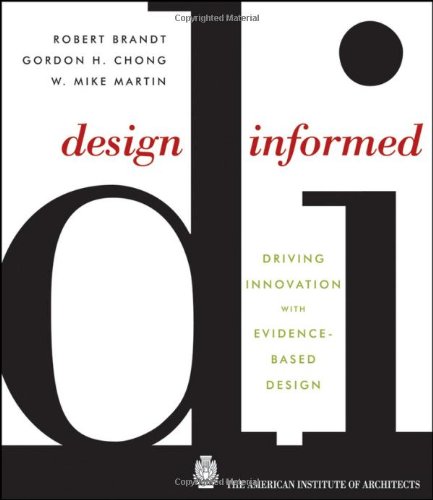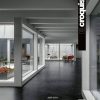Design Informed Driving Innovation with Evidence Based Design 1st Edition by Gordon Chong, Robert Brandt, Mike Martin 0470395621 978-0470395622
$50.00 Original price was: $50.00.$35.00Current price is: $35.00.
Design Informed Driving Innovation with Evidence Based Design 1st Edition by Gordon Chong, Robert Brandt, Mike Martin – Ebook PDF Instant Download/Delivery: 0470395621, 978-0470395622
Full download Design Informed Driving Innovation with Evidence Based Design 1st Edition after payment

Product details:
ISBN 10: 0470395621
ISBN 13: 978-0470395622
Author: Gordon H. Chong, Robert Brandt, W. Mike Martin
This practical, accessible book―for design professionals and students alike―is about design excellence and how to achieve it. The authors propose an evidence-based design approach that builds on design ingenuity with the use of research in ways that enhance opportunities to innovate. They show the power of research data to both reveal new design opportunities and convince stakeholders of the value of extraordinary work. A guide for all designers who want to earn their place as their clients’ trusted advisor and who aspire to create places of beauty and purpose, the book demonstrates:
-
An approach to applying evidence to design that neither turns designers into scientists nor requires large-firm resources
-
The wide range of types of evidence that can be applicable to design and where to look for it
-
Direct, practical application of the evidence-based design approaches in use today
-
Provides tools to distinguish strong evidence that can improve design decisions from misleading assertions resulting from weak research
-
Benefits of evidence-based design, including improved human and building performance
Two featured case studies illustrate the theory and practice of evidence-based design. The work of the authors’ 2005–2007 AIA College of Fellows Benjamin Latrobe Research Fellowship provided an empirical foundation for this book, and addresses the use of rigorous research methods to understand relationships between design choices and health outcomes. The California Academy of Sciences, designed by Renzo Piano Building Workshop, Chong Partners Architecture, and Arup, provides transparent evidence that enhances building technology performance in the context of a powerful design expression.
In-depth interviews and case studies are clustered around three research categories: modeling, simulation, and data mining; social and behavioral science and the physical and natural sciences; and including cutting-edge use of neuroscience to understand human response to physical environments. The twenty-two featured thought leaders include: William Mitchell, MIT Media Lab; Fred Gage, Salk Institute; Phil Bernstein, Autodesk; Sheila Kennedy, Kennedy & Violich; James Timberlake, KieranTimberlake; William and Chris Sharples, SHoP Architects; Vivian Loftness, Carnegie Mellon University; John Zeisel, Hearthstone; Paco Underhill, Envirosell; Susan Ubbelohde and George Loisos, Loisos+Ubbelohde Architecture-Energy; Chris Luebkeman, Arup; Martin Fischer, Stanford University CIFE; and Kevin Powell, GSA.
Design Informed Driving Innovation with Evidence Based Design 1st Table of contents:
Copyright
Preface
Acknowledgments
1. Transformation
1.1. “Evidence for Design” or “Evidence or Design?”
1.1.1.
1.1.1.1. “Evidence for Design” or “Evidence or Design?”
1.1.1.2. Not As It Seems
1.1.1.3. Time for a Makeover
1.1.1.4. What Will It Look Like?
1.1.1.5. The Authors’ Journey
1.1.1.6. The Road Well Taken
2. Models, Simulation, and Data Mining
2.1. Background and Context
2.1.1.
2.1.1.1. Introduction
2.1.1.2. Overview of Models, Simulation, and Data Mining
2.1.1.3. The Influences of Physical Models, Prototyping, Testing, and Simulation on Architecture
2.1.1.4. Models, Simulation, and Data Mining
2.1.1.5. The Research Methods of Modeling, Simulation, and Data Mining
2.1.1.6. Physical Modeling, Prototyping, Testing, and Simulation Research Opportunities for Use, Best Practices, and Best Context
2.2. Interviews of Experts and Case Studies
2.2.1. RESEARCH BACKGROUND
2.2.2. RESEARCH BACKGROUND
2.2.3. PHASE I: PROOF OF CONCEPT FROG TO FROG ZERO—THE HAWAII NET-ZERO CLASSROOM
2.2.4. PHASE II: ANALYSIS METHODOLOGY APPLIED TO MULTIPLE CLIMATES
2.2.5. PHASE III: CUSTOM ZERO FROGS FOR SPECIFIC SITES AND CLIENTS
2.2.6. PHASE IV: REGIONAL VARIATION IN FROG ZERO SOLUTIONS
2.2.7. BUILDING PERFORMANCE: ENERGY EFFICIENCY
2.2.8. BUILDING PERFORMANCE: OCCUPANT COMFORT AND THE CONCEPT OF GENTLE FAILURE
2.2.9. RESEARCH BACKGROUND
2.2.10. RESEARCH BACKGROUND
2.2.11. RESEARCH BACKGROUND
2.2.12. GENERATING OPTIMAL STRUCTURES
2.2.13. PANELIZING CURVY SURFACES
2.2.14. BUILDING ENVELOPE OPTIMIZATION
2.2.15. RESEARCH BACKGROUND
2.2.16. RESEARCH BACKGROUND
2.2.17. OVERVIEW
2.2.18. PROBLEM STATEMENT
2.2.19. FINDINGS
2.2.20. THE PROCESS TO CREATE A NEW FABRIC ALLIANCE PROGRAM
2.2.21. RESEARCH AND DATA GATHERING
2.2.22. NARROWING THE FIELD
2.2.23. VENDOR PRESENTATIONS
2.2.24. FINISH AND TREATMENT MANUFACTURERS
2.2.25. DECISIONS AND RECOMMENDATIONS
2.2.26. NEXT STEPS
2.2.27. RESEARCH BACKGROUND
2.2.28. INTRODUCTION
2.2.29. PM4D APPROACH
2.2.30. MAJOR BENEFITS
2.2.31. MAJOR BARRIERS TO EXTENDING PM4D BENEFITS
2.2.32. CONCLUSIONS AND RECOMMENDATIONS
2.3. Lessons Learned: Models, Simulation, and Data Mining
2.3.1.
2.3.1.1. Overview
2.3.1.2. General Observations About Modeling, Simulation, and Data Mining
2.3.1.3. The Challenges
2.3.1.4. The Summary
REFERENCES
3. The Social Sciences
3.1. Background and Context
3.1.1.
3.1.1.1. Overview of the Social Sciences
3.1.1.2. The Influence of Social Science and Environmental Psychology on Architecture
3.1.1.3. Primary Areas of Investigation
3.1.1.4. Methods
3.1.1.5. Tools
3.1.1.5.1. Ask
3.1.1.5.2. Observe
3.1.1.6. REFERENCES
3.2. Interviews of Experts and Case Studies
3.2.1. RESEARCH BACKGROUND
3.2.2. RESEARCH BACKGROUND
3.2.3. INTRODUCTION
3.2.4. THE RESEARCH QUESTION
3.2.5. METHODOLOGY
3.2.6. THE MAIN FINDINGS
3.2.7. IMPORTANCE OF THIS RESEARCH TO THE DESIGN PROFESSIONS
3.2.8. RESEARCH BACKGROUND
3.2.9. INTENT
3.2.10. METHODOLOGY
3.2.11. FINDINGS
3.2.12. SIGNIFICANCE
3.2.12.1. REFERENCES
3.2.13. RESEARCH BACKGROUND
3.2.14. RESEARCH BACKGROUND
3.2.15. RESEARCH BACKGROUND
3.3. Lessons Learned
3.3.1.
3.3.1.1. Pragmatism
3.3.1.2. Standards
3.3.1.3. Creativity
3.3.1.4. Moving Forward
4. The Natural and Physical Sciences
4.1. Background and Context
4.1.1.
4.1.1.1. Overview
4.1.1.2. The Influence of Natural and Physical Science on Architecture
4.1.1.3. Neuroscience
4.1.1.3.1. Anatomy of the Brain and its Functions
4.1.1.3.2. Imaging Technologies
4.1.1.3.3. Neuroplasticity
4.1.1.4. Current Examples of Research, Hypothesis, and Work in Process
4.1.1.5. The Research Methodology of Natural and Physical Science
4.1.1.6. Natural/Physical Scientific Research Opportunities, Best Applications, and Best Context
4.2. Interviews of Experts and Case Studies
4.2.1. RESEARCH BACKGROUND
4.2.2. RESEARCH BACKGROUND
4.2.3. RESEARCH BACKGROUND
4.2.3.1.
4.2.3.1.1. Thermal Comfort:
4.2.3.1.2. Air Quality:
4.2.3.1.3. Productivity:
4.2.3.1.4. Summary Discussion:
4.2.4. RESEARCH BACKGROUND
4.2.5. RESEARCH BACKGROUND
4.2.6. RESEARCH BACKGROUND
4.3. Lessons Learned
4.3.1.
4.3.1.1. The Physical Sciences: Building Performance
4.3.1.2. The Natural Sciences: Neuroscience
REFERENCES
5. Putting It All Together
5.1. Background and Context
5.1.1.
5.1.1.1. Piano Design Philosophy
5.1.1.2. Client Leadership and Insight
5.1.1.3. Project Facts
5.2. The Primary Research Methodologies Utilized
5.2.1.
5.2.1.1. Case Study: Use of Social Scientific Evidence
5.2.2. USE OF LITERATURE SEARCH TO CONFIRM VALIDITY OF METHODOLOGY
5.2.3. SUMMARY OF RESULTS
5.2.3.1. REFERENCES
5.2.3.2. Photo Credits
6. The 2005 Latrobe Fellowship
6.1. Introduction
6.2. Process Model and Methodologies
6.2.1.
6.2.1.1. Why Three Perspectives?
6.2.1.2. Why Behavioral, Biomedical, and Neuroscience Methods?
6.2.1.3. The Research Plan
6.2.1.4. Key Findings about the Model and Methodologies
6.3. Literature and Experimental Findings
6.3.1.
6.3.1.1. Literature about Evidence-Based Practice
6.3.1.2. Lighting Design Literature
6.3.1.3. The Laboratory Experiment
6.3.1.3.1. Evidence circadian systems need darkness as well as light
6.3.1.3.2. Evidence: Natural Light Cycles Promote Health; Circadian Systems Need Varied Light Conditions
6.3.1.3.3. Evidence: Individuals Have Different Light Needs
6.4. Credits
6.4.1.
6.4.1.1. Core Team
6.4.1.2. Contributors
7. Applying What We’ve Learned
7.1. What Does This Mean for Design Practice?
7.1.1.
7.1.1.1. What Does This Mean for Design Practice?
7.1.1.2. Expanded Horizons
7.1.1.3. Strength of Evidence
7.1.1.4. The Right Methodology and the Right Metrics
7.1.1.4.1. Summarizing, we believe that there are six attributes of quality research for design:
7.1.1.5. Where Do We Go from Here?
7.1.1.6. How?
7.1.1.7. The Most Fruitful, Near and Long-Term Areas for the Application of Evidence-Based Design
7.1.1.8. A Final Word
People also search for Design Informed Driving Innovation with Evidence Based Design 1st :
what is design driven innovation
design-driven innovation examples
what is design innovation
informed innovation
Tags:
Gordon Chong,Robert Brandt,Mike Martin,Design Informed



